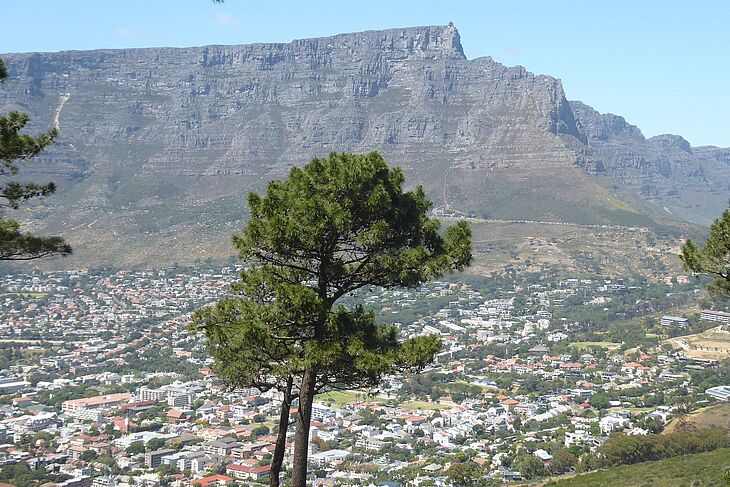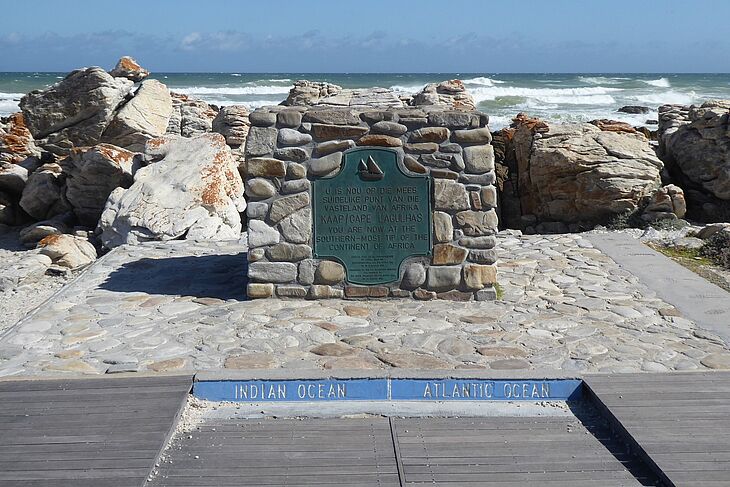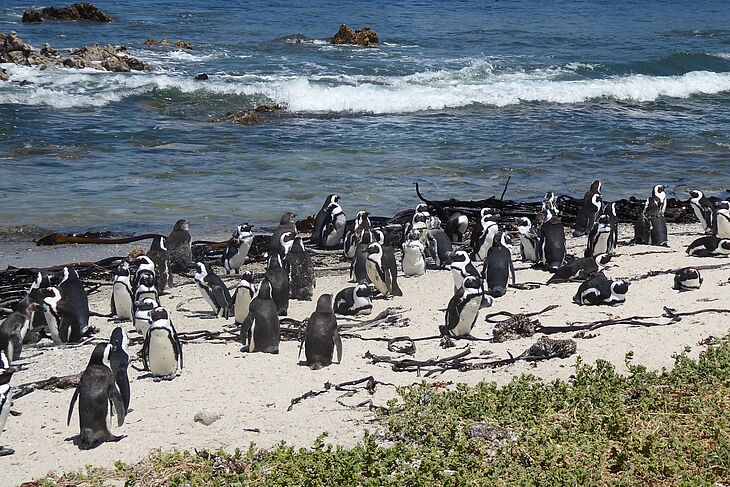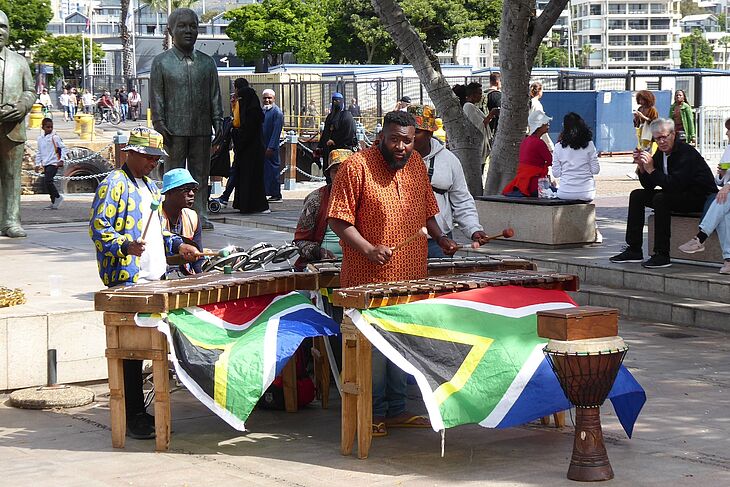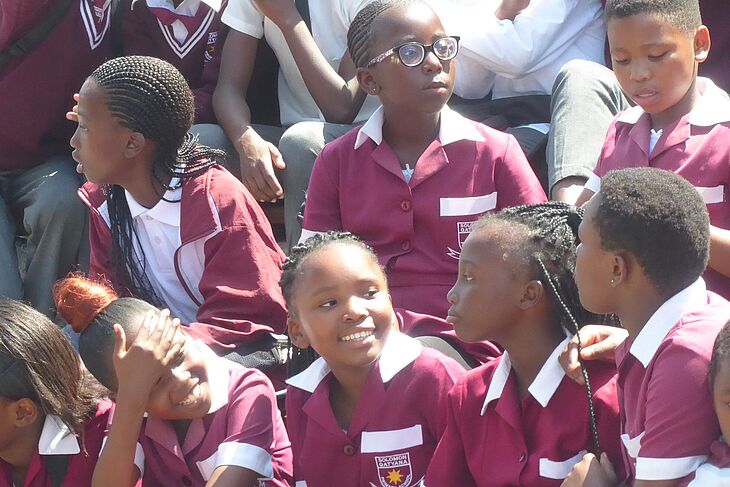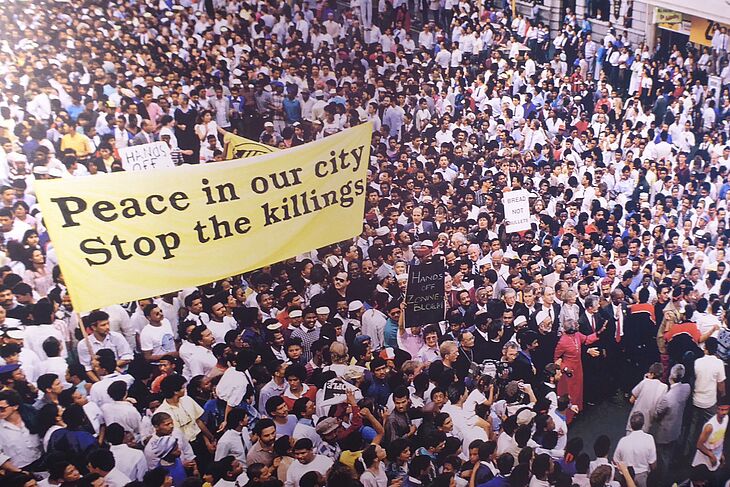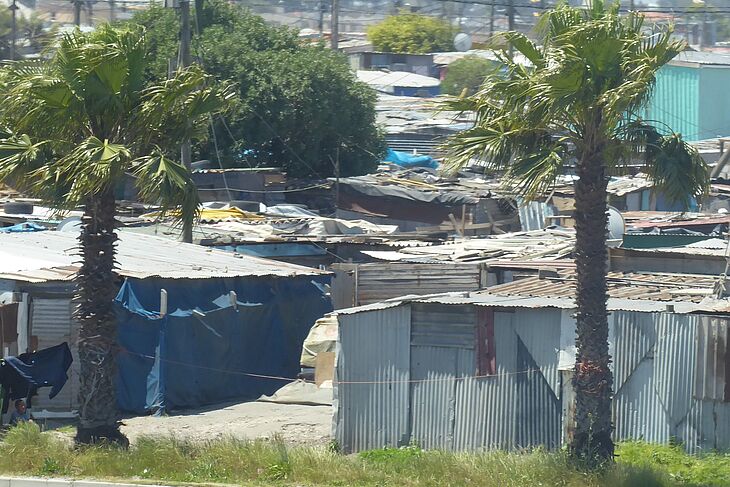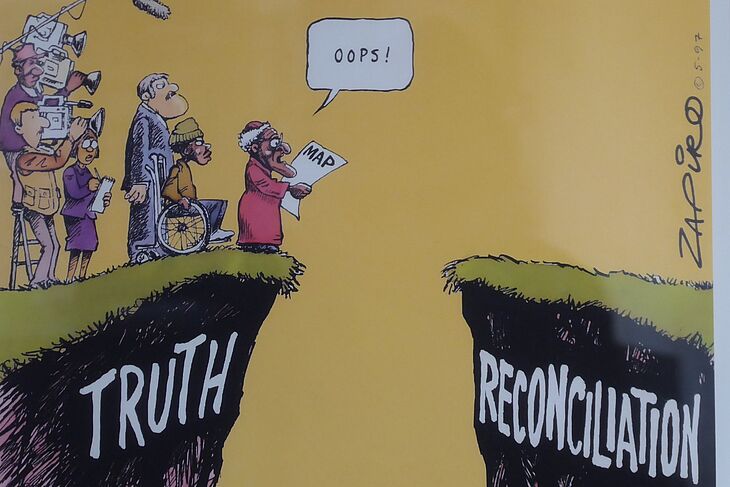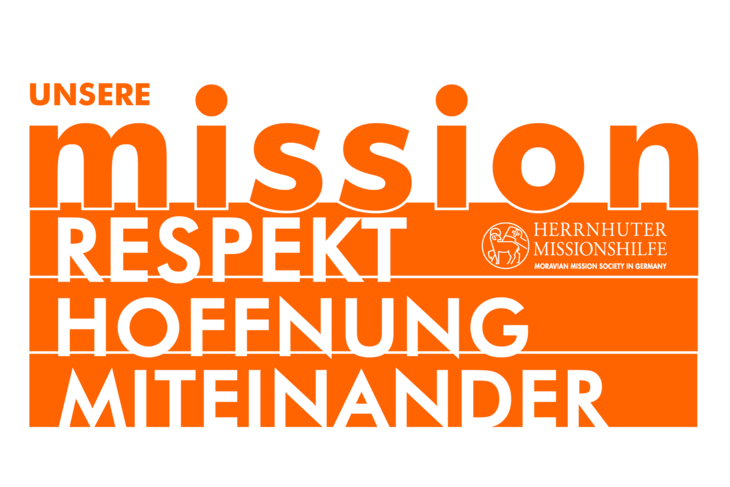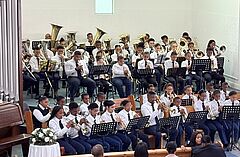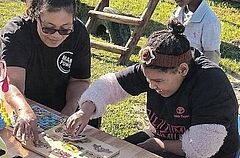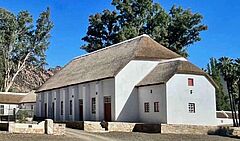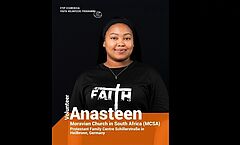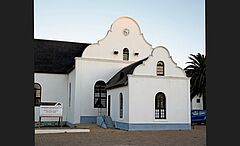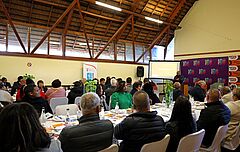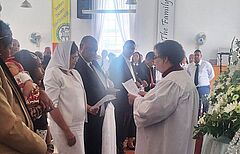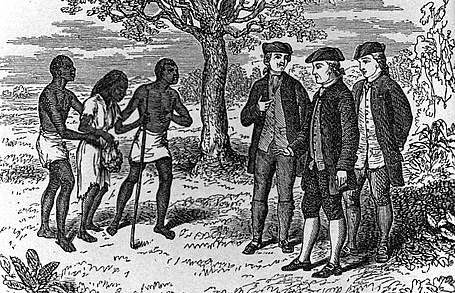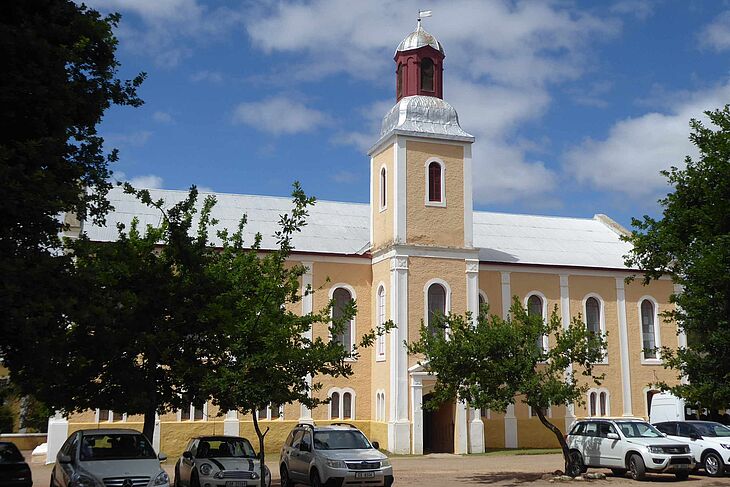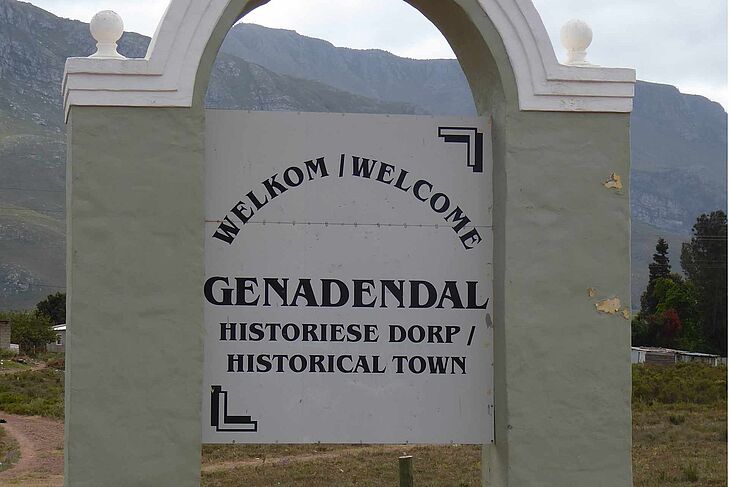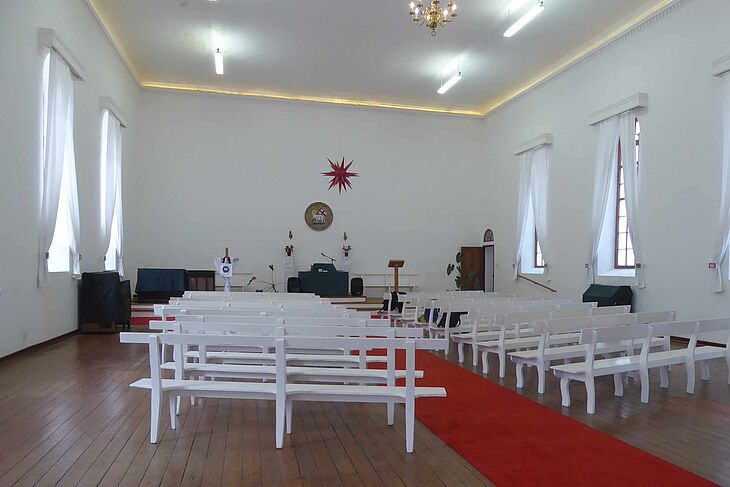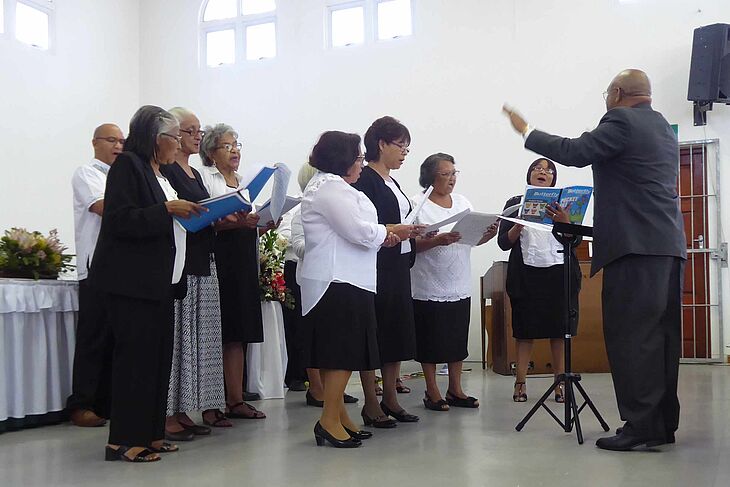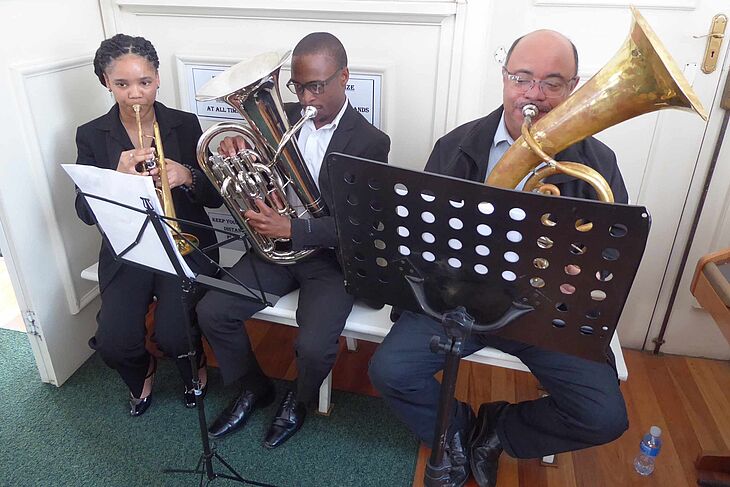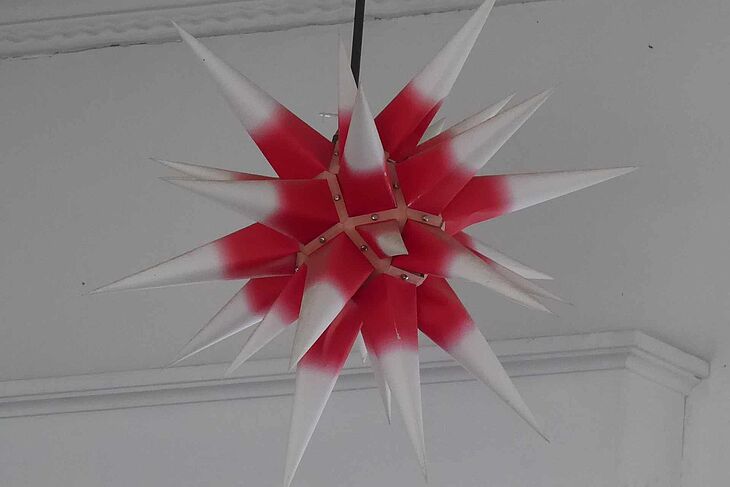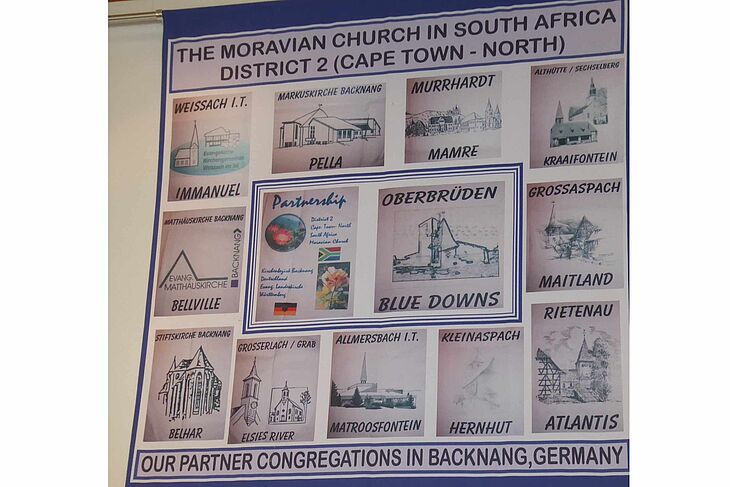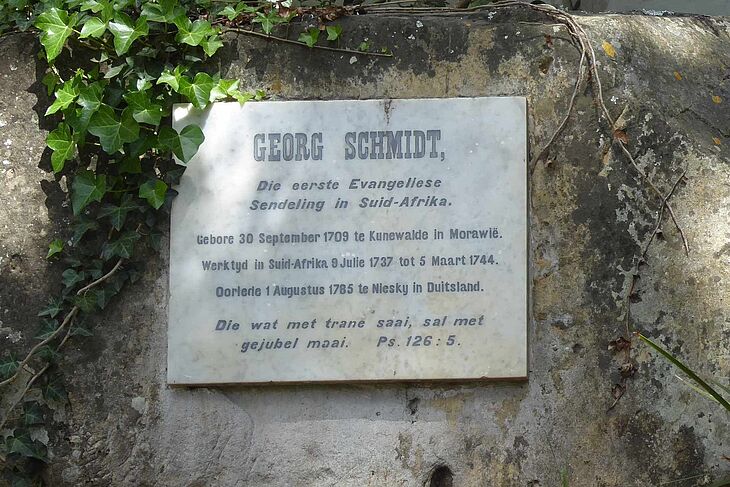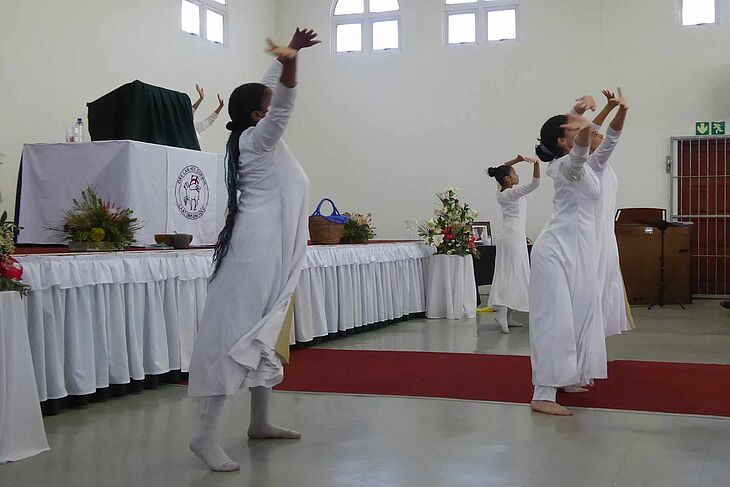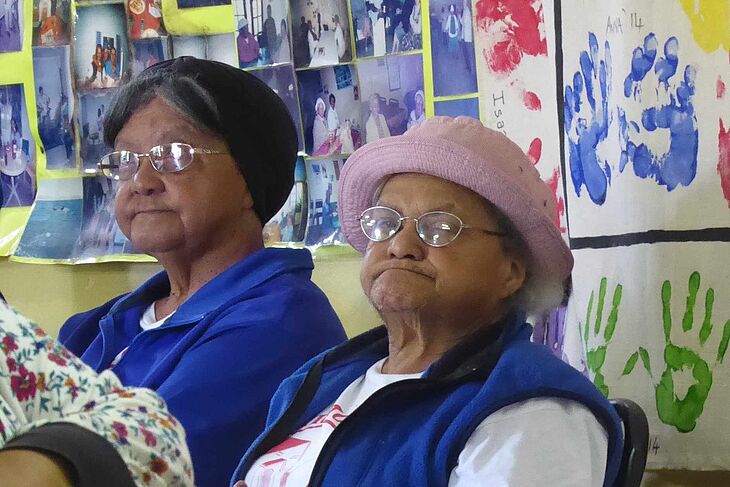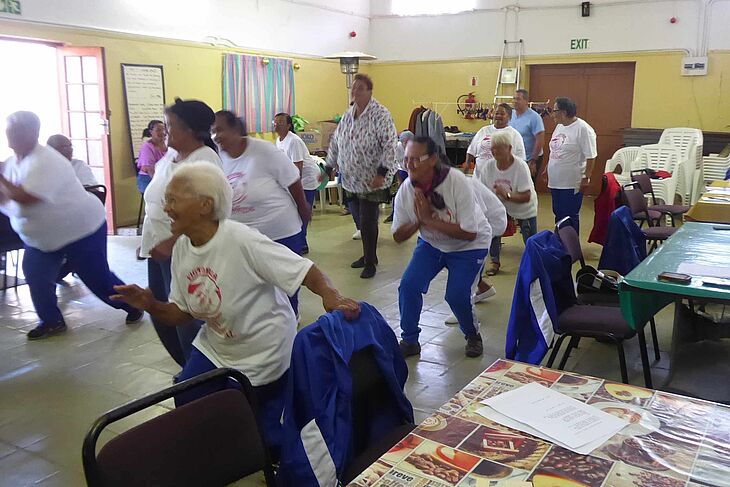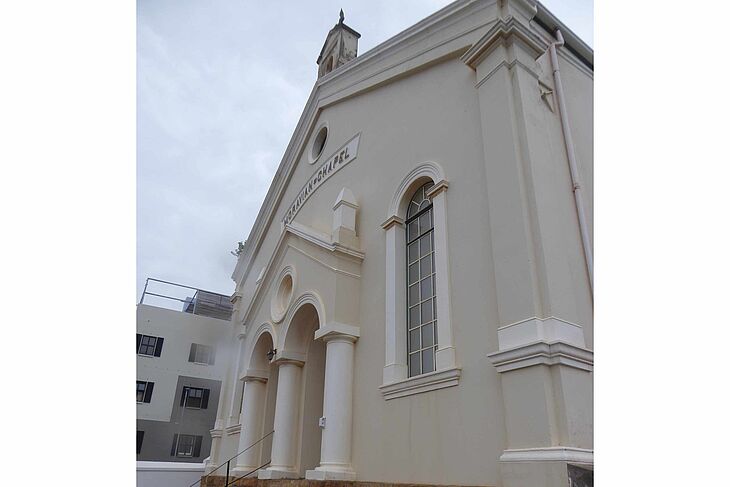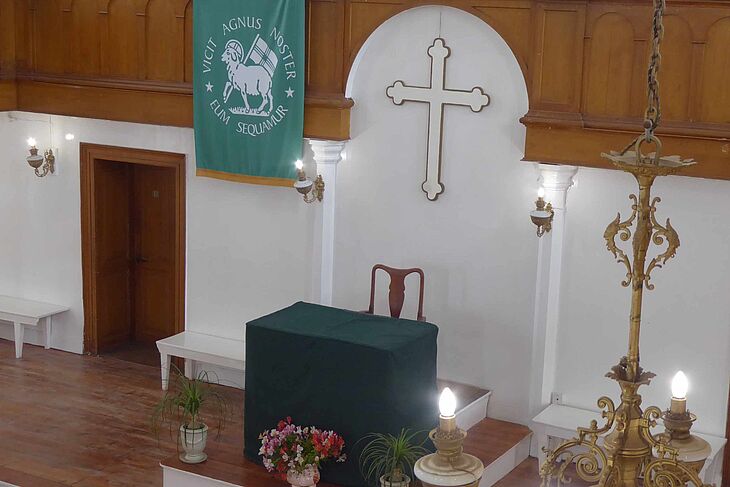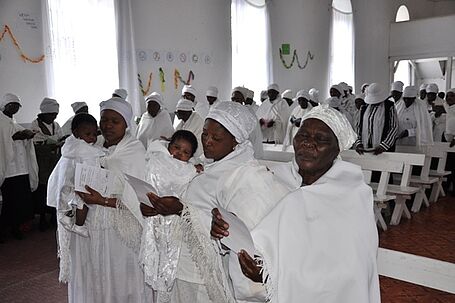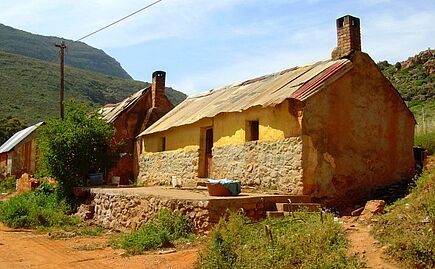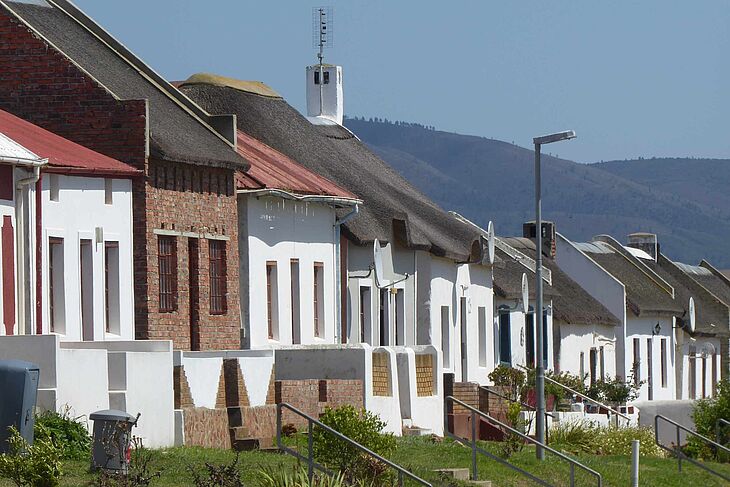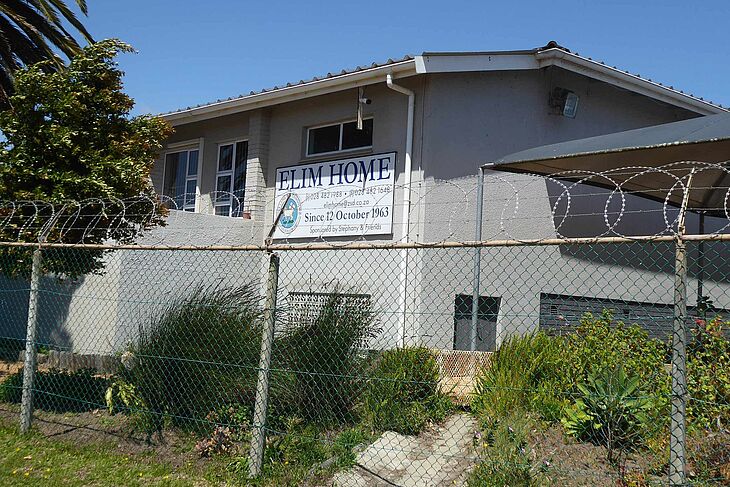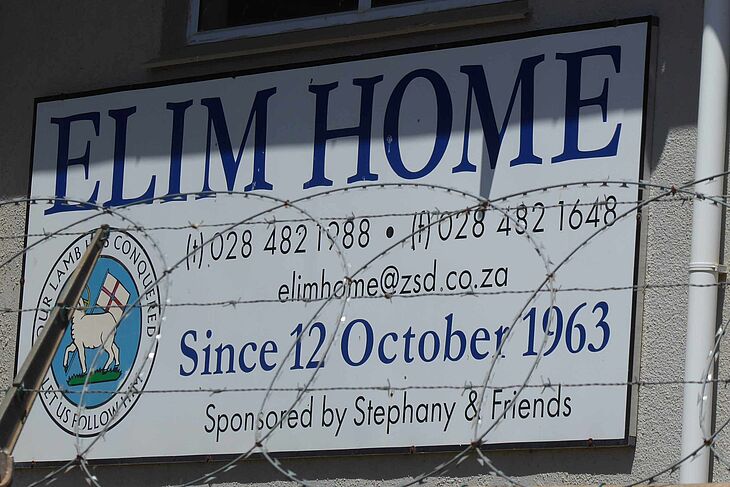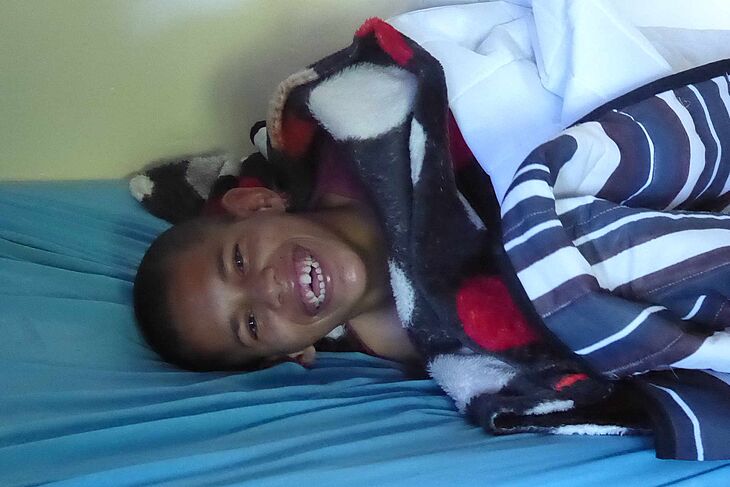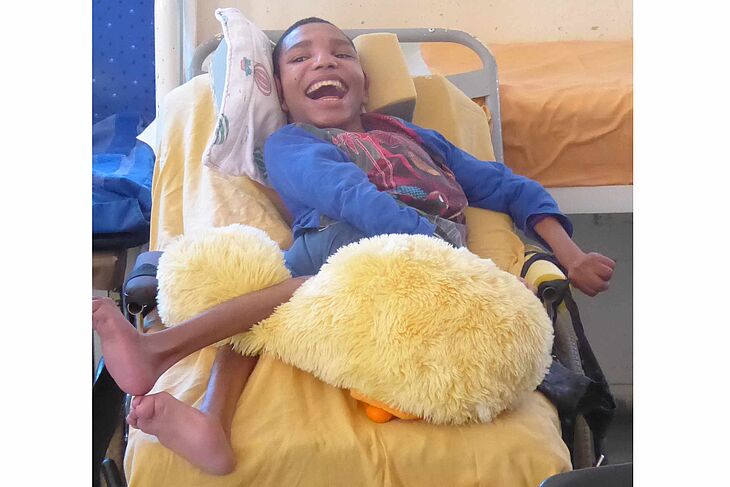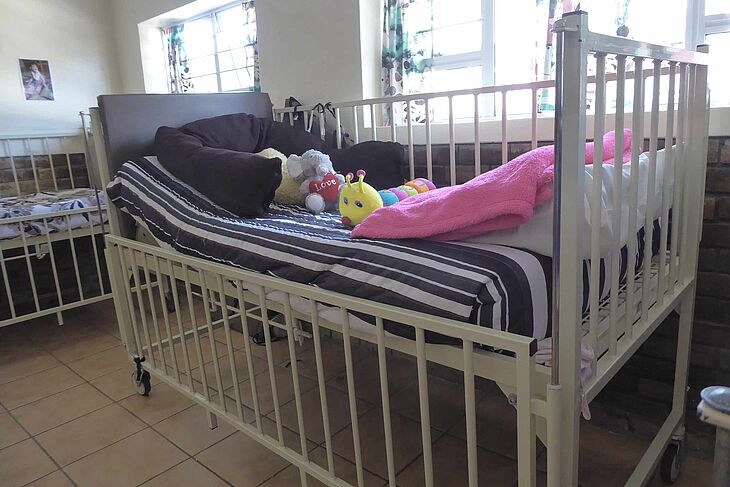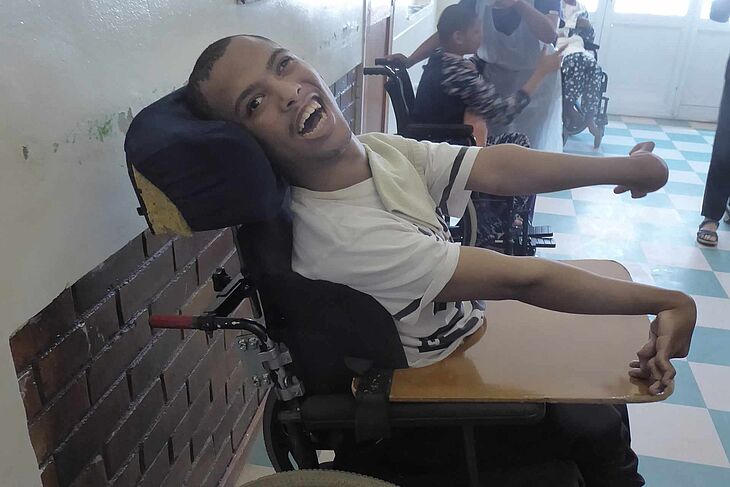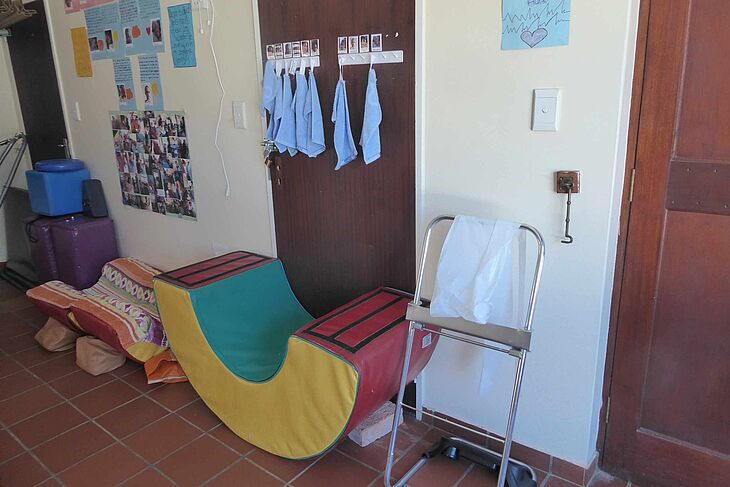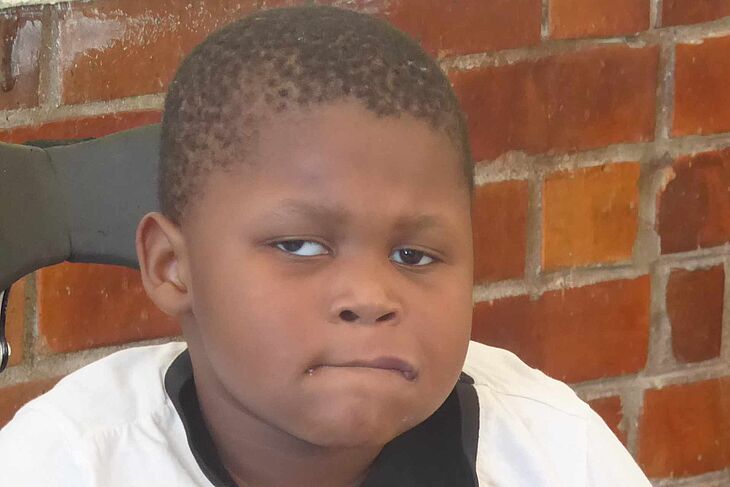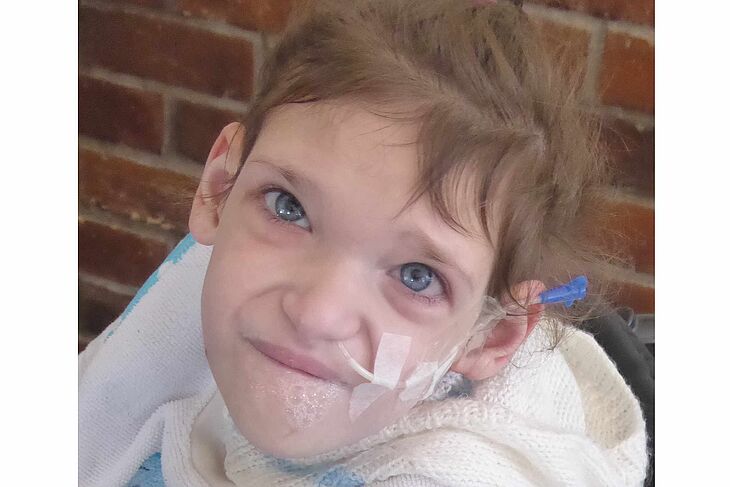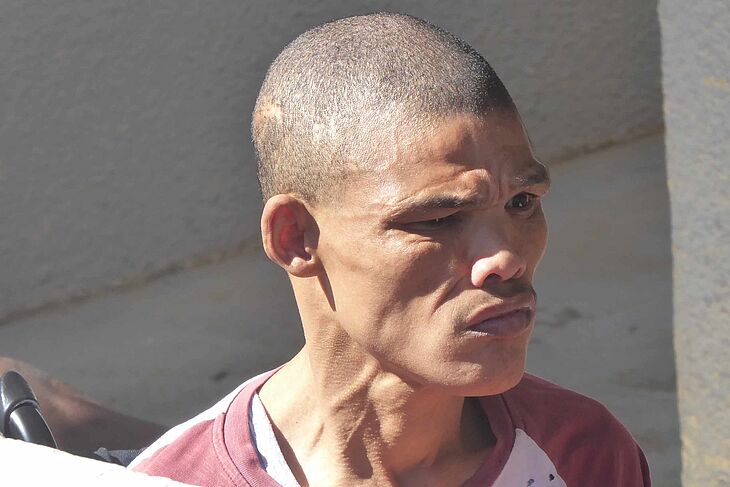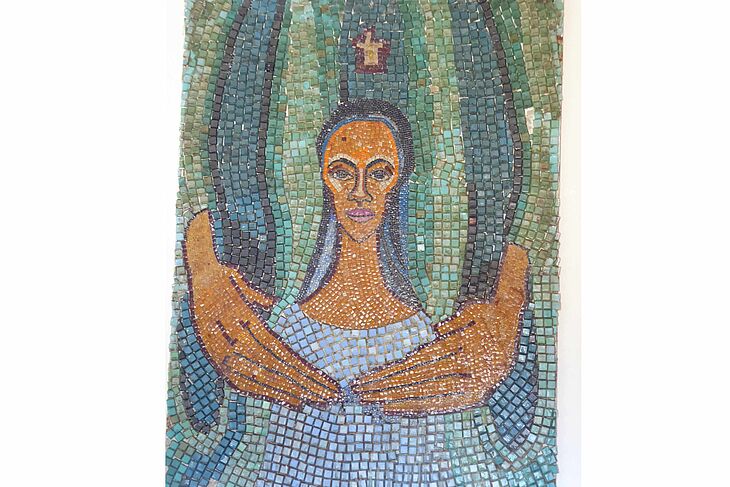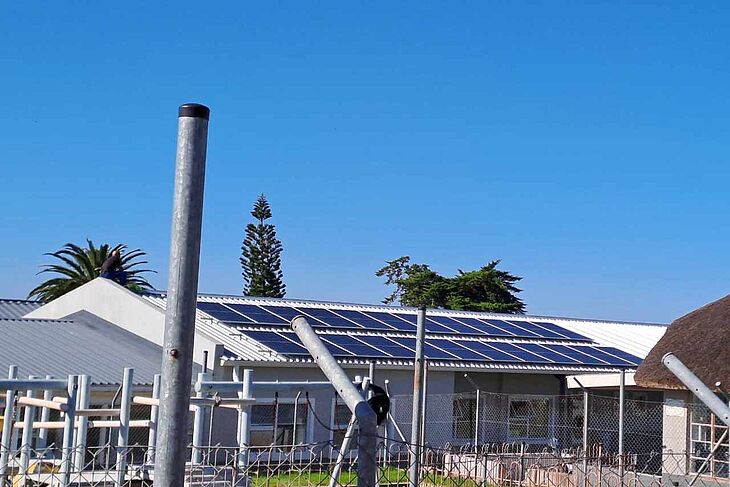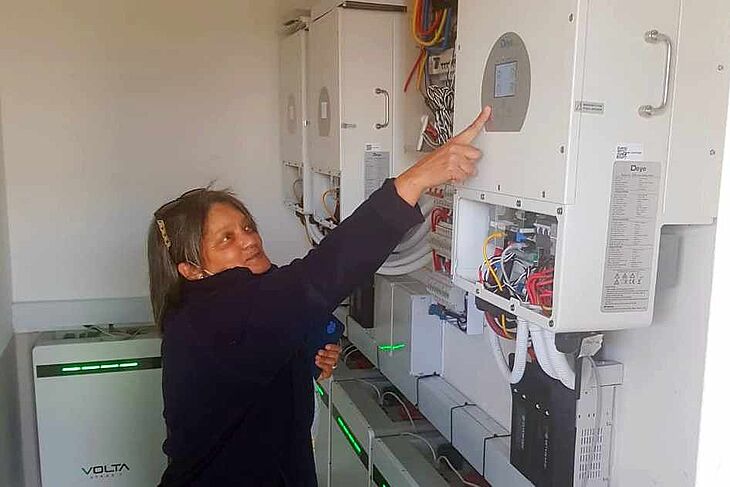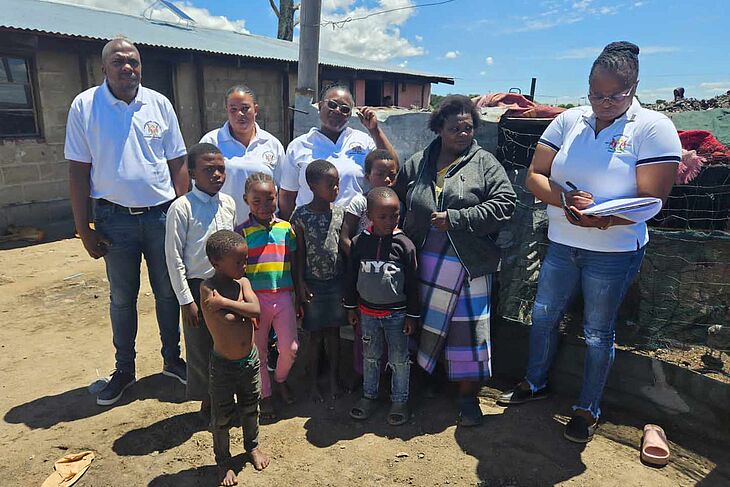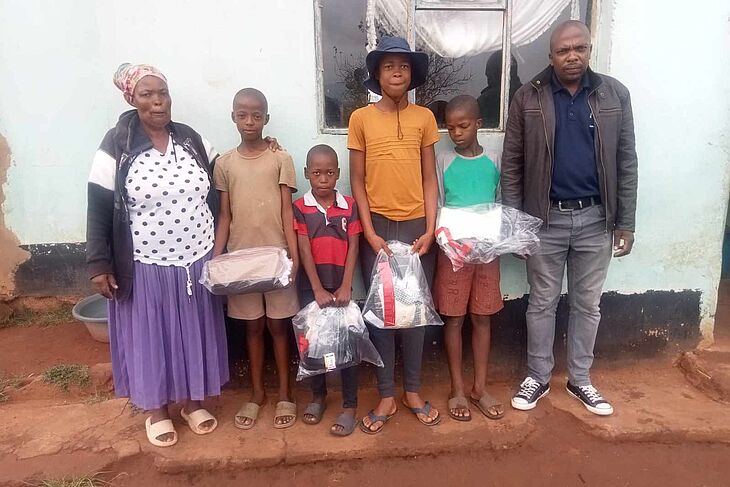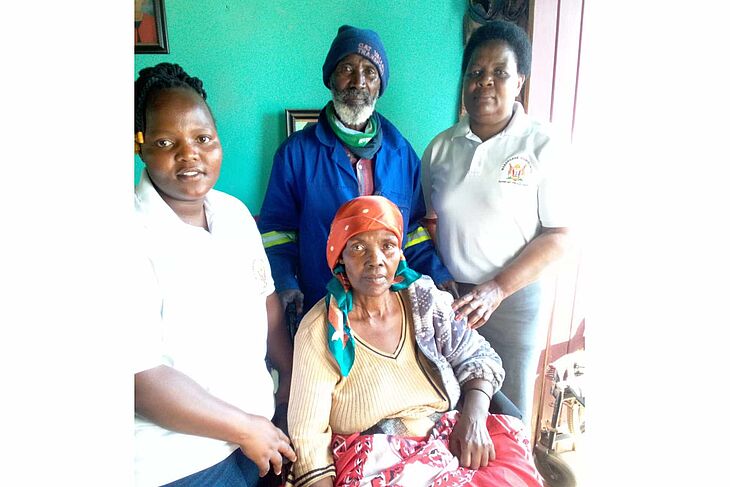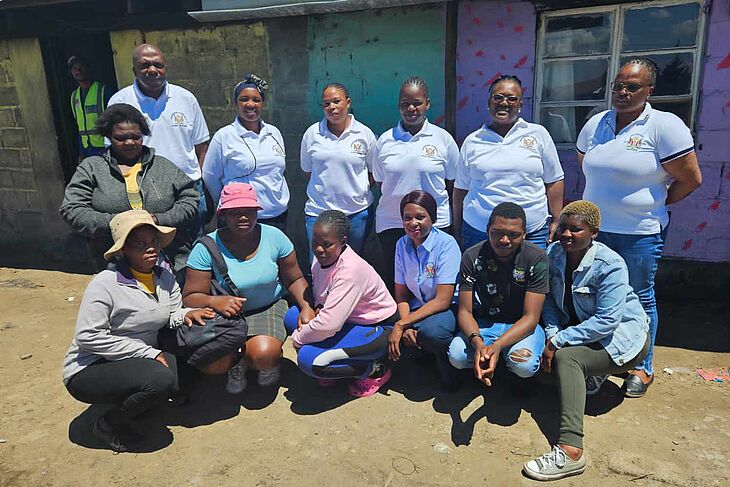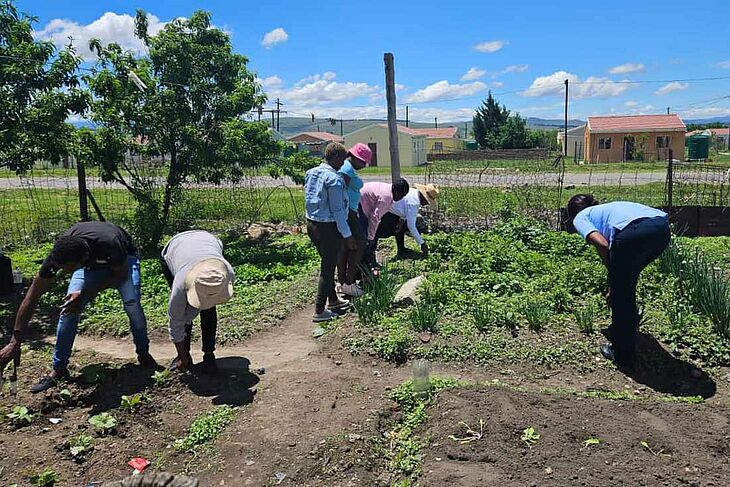South Africa
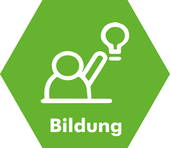

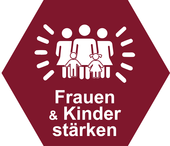

With almost 3,000 kilometres of coastline, South Africa intersects two oceans at its southern tip, Cape Agulhas: the Atlantic Ocean (to the west) and the Indian Ocean (to the south and east). It covers an area of 1.2 million square kilometres, making it more than three times the size of Germany. The country is dominated by a plateau up to 2,000 metres high, which breaks off towards the coasts. The highest mountain, Thabana Ntlenyana at 3482 metres, is located in the south-east in the Drakensberg Mountains.
The climate in South Africa is predominantly sunny and dry. Rainfall decreases from south-east to north-west, while temperatures increase. The seasons are exactly opposite to those in Europe. Only 1% of the total area of South Africa is forested; savannah areas with a very diverse flora and fauna predominate.
The population is made up of 81.4% black Africans, 8.2% coloureds, 7.3% whites and 2.7% Indians and Asians.
11 official languages are spoken in South Africa: English (lingua franca), Afrikaans and nine Bantu languages. The most widely spoken language is Zulu, followed by Xhosa. 68.5 % profess Christianity, 15 % are of no denomination, 1.5 % belong to Islam and 14.6 % to other religions.
The focus of the South African economy has shifted from agriculture and mining to manufacturing and services. The unemployment rate is 32.8 % (as of 2023, and rising), with almost 50 % of the young population unemployed.
project pictures
News from the projects
EMS launches fundraising campaign to rebuild the church in Clarkson
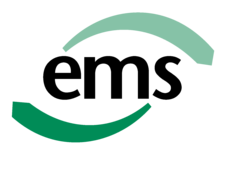
On November 25, 2025, the Moravian Church in Clarkson was completely destroyed by a devastating fire. The church had been a place of prayer and fellowship for the local community since 1839. In a very short time, the historic building fell victim to the flames - a painful loss for the congregation and the entire Moravian Church South Africa MCSA. The bishops of the MCSA wrote in their pastoral letter: “It was with deep sadness that we learned of the fire at the church in Clarkson. Our sympathy goes out to the congregation and all the people of Clarkson. We include you in our prayers. You are not alone in this difficult time!” To support the congregation and enable the reconstruction of the church building, the Evangelical Mission in Solidarity EMS has set up a donation fund. Every donation helps to give hope and confidence: Evangelical Mission in Solidarity, IBAN: DE85 5206 0410 0000 0001 24 (BIC: GENODEF1EK1), reference: Clarkson. Evangelische Bank eG. Thank you very much for your solidarity!
Moravian Church in Clarkson completely destroyed in a fire

The bishops of the Moravian Church of South Africa MCSA announced in a circular letter dated November 29, 2025: "It was with deep sadness that we learned of the fire at the Moravian Church in Clarkson on November 25, 2025. Thanks to the speed of social media, we were even able to witness it in real time. Within a very short time, the church, where the local community had been worshipping since 1839, was tragically destroyed by the flames. The fires in Wupperthal and Wittewater are still fresh in the minds of us Moravians. Now our grief is compounded by this new tragedy! Our deepest sympathy goes out to the congregation and all the people of Clarkson." Several initiatives are underway to support the congregation: A donation fund has been set up. On Saturday, December 13, 2025, there will be a concert in Bloemendal to benefit the restoration of the church building. The entire newsletter here.
Information about the Clarkson mission station, whose church recently burned down
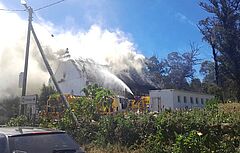
Clarkson in the Tsitsikamma region of South Africa was established as a mission station of the Moravian Church. It was founded in 1839 by Bishop Hans Peter Hallbeck for five colored families from Enon and a Fingo chief with his entourage of farmers. A man named Thomas Clarkson donated 200 British pounds to build the mission station, which was then named after him. The station had only one street, Church Street. The colored people lived on one side, and the black Fingo, Xhosa-speaking people, lived on the other. The church building was consecrated in December 1840. In the fire on November 25, 2025, the organ, the piano, and all the pews were destroyed along with the church. According to the police, there is no evidence of arson so far; it is assumed that a bush fire spread to the church. The church had the status of a provincial heritage monument in the Eastern Cape. More here.
Martin Abrahams passed away in South Africa
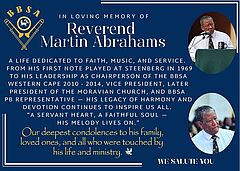
The former chair of the church leadership of the Moravian Church in South AfricaMCSA, Martin Abrahams, passed away on November 4, 2025, at the age of 64. He was born on November 7, 1960, in Cape Town. Throughout his life, he was involved in a variety of ways in the church and partnerships. Until October 2024, he was president of the MCSA. His tenure also saw the important reconciliation with the Dutch Reformed Church, which culminated in a moving reconciliation service and a public admission of guilt on September 24, 2022, in Gnadendal. He was also deeply involved with the Evangelical Mission in Solidarity EMS, the World Council of Churches WCC and the Lutheran World Federation LWF.The funeral will be held on November 15, 2025, in Goedverwacht. We ask for your prayers for his family.
Brass band festivals in Bloemendal and Wupperthal
October is the most important month of the year for the Moravian Brass Band Union of South Africa (BBSA). The BBSA Eastern Cape Junior Band Festival has already taken place at the Bloemendal Moravian Church. On October 12, 2025, the festival management wrote on Facebook: "What a blessed and joyful event our Junior Brass Festival was! Thanks to everyone who was there, who clapped, sang, and prayed along with us. You made the day unforgettable. Our young musicians are talented. They were diligent and played with dedication. Truly, this was a day that the Lord made. We rejoiced and were glad! Our BBSA has a bright future. The next generation of brass players is ready. Young brass players, keep the spirit alive, keep making music, and remember: one brass choir, one sound!" More here. On October 19, 2025, the BBSA Eastern Cape Senior Festival took place in Wupperthal. Poster here.
In focus: the “Elim Home” support center
The Elim Home support center run by the Moravian Church in South Africa—located very close to the southern tip of the African continent—is once again being highlighted on Facebook by the Zeister Missionsgesellschaft in the Netherlands. See here. Under the motto Every life is precious, the support center writes about itself: "For over 60 years, we have been offering children and young people with mental and physical disabilities guidance, care, and a life of dignity. Many of our clients come from difficult social backgrounds. Without the Elim Home, they would have no access to medical treatment and loving care. We care for 50 children at Elim day and night. Another 33 children attend day care centers in Gansbaai and Bredasdorp near Elim. Here they receive food, medicine, physical therapy, and occupational therapy – and above all, safety."
30 years ago - Mandela in Gnadendal
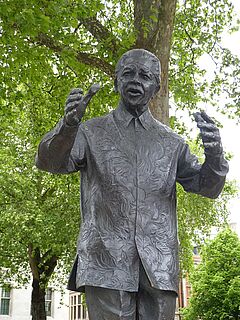
Thirty years ago, on October 10, 1995, the then South African President Nelson Mandela (1918-2013) visited the historic Moravian Church in Gnadendal. Nelson Mandela spent a long time in prison during apartheid because he advocated for equal rights for all ethnic groups in South Africa. In 1994, he became South Africa's first non-white president and played a key role in ensuring that the transition from the unjust apartheid regime to democracy was essentially peaceful. The Moravian Church South Africa (MCSA) was an important companion for Nelson Mandela on the path to reconciliation in South African society. A video of the 1995 visit can be found here.
Stories of strength and community in Genadendal
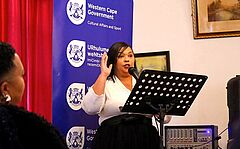
On Friday, August 8, 2025, the Mission Museum of the Moravian Church in Genadendal, South Africa, was transformed into a place of healing memories, music, and storytelling. The museum had invited guests to attend Almal se Stoepstories / In her Own Words, an event dedicated to oral history featuring the voices of women from Genadendal. Guests were welcomed with the cheerful sounds of the Genadendal Brass Band. The program was opened by Sylvinia Oliver from Bredasdorp, a motivational speaker. With grace and sincerity, she spoke about resilience and determination. The focus was then on the stories of four remarkable women (Connie Fisher/teacher and municipal councilor; Elizabeth Kupido/factory worker; Joan Erasmus/kindergarten teacher; Cathleen Beyers/housewife and mother of several children). The women's stories each represented the power and great strength that lives in the Valley of Grace. More here.
Photo report on the successful reconstruction of Wupperthal in South Africa
The South African website The Heritage Portal recently published a lengthy, impressively illustrated article by Graham Jacobs about the Wupperthal mission station near Cederberg (Western Cape), which was founded in 1830. Parts of the heritage-listed site were devastated by a devastating fire on the night of December 30 to 31, 2018. Of the 113 residential buildings in the village, 53 (most of them historically significant buildings) were completely destroyed. In terms of the number of buildings destroyed, the fire disaster in Wupperthal at the end of 2018 is considered the worst disaster in South Africa since the earthquake in and around Tulbagh in 1969. The article on the above-mentioned website documents the great successes achieved so far in rebuilding the town. Under the heading “Wupperthal – From Fire to Restoration,” many buildings are presented in their destroyed state and after reconstruction. More information in English can be found here.
Three young women from South Africa arrive in Germany as volunteers
Faith (23), a young woman from Bredasdorp on the southern tip of South Africa, was nominated by the Moravian Church in South Africa (specifically by the Moravian Sunday School Union in South Africa) for a volunteer position in Germany. Through the Ecumenical Volunteer Program of the Evangelical Mission in Solidarity (EMS), she left for a twelve-month assignment at the Johannes Kindergarten in Ettlingen near Karlsruhe. See here. Her sister Zingce (23) from Whittlesea near Queenstown (now Komani) in South Africa's Eastern Cape region is completing a year of voluntary service in the ecumenical community of the Moravian Church on the Herrnhaag near Büdigen in Hessen. See here. And Anasteen (24) from the Western Cape region is working for a year as a volunteer at the Evangelical Family Center Schillerstraße in Heilbronn in day care and at the affiliated kindergarten. See here. God's blessings to all three young people for their service in Germany.
About the land disputes in the Moravian Church of Goedverwacht
In several Moravian Church communities in South Africa, families from the indigenous population are striving to acquire as personal property the land they have been using for 200 years, mostly free of charge, but which ultimately belongs to the Moravian Church in South Africa. On June 29, 2025, the weekly online magazine Mail & Guardian published a very long article about these disputes in the Moravian Church community of Goedverwacht, which has about 2,000 inhabitants, is located 150 kilometers west of Cape Town, and was founded in 1810. The article in English is entitled Moravian Church legal battle at heart of indigenous land rights. See here. The article states: "The Moravian Church does not just own church buildings, bells and items for worship. It controls entire villages – mission stations – and hundreds of thousands of hectares of land. It also has its own financial services and property management company. Almost three centuries later, the people who lived on the land, mostly Khoi, want to control and govern the land their ancestors worked and which some consider their natural property."
Education symposium with the Kaapse/Cape Forum in Genadendal
The Mission Museum of the Moravian Church in Genadendal and the non-profit South African Kaapse/Cape Forum joined forces on July 8, 2025, to organize an educational symposium in Genadendal. The forum's goal is to “improve the living conditions of all congregations in the Western Cape by promoting community autonomy, self-help activities, strengthening democracy, and further developing federalism.” Nearly 100 committed participants, including teachers, school principals, education experts, and community leaders, experienced what is possible when people come together to achieve a common goal during a multi-hour event in Genadendal. The atmosphere was lively, hopeful, and marked by meaningful conversations that will resonate far beyond the walls of the venue. More here. The day ended with the honoring of the Cape Champions, individuals and institutions that have shown particular commitment to promoting their communities through educational work.
Hardworking sisters at the Ebenhaeser Moravian Church
The Ebenhaeser Moravian Church in Gqeberha-Bethelsdorp (until 2021 Port Elizabeth, South Africa) proudly announces the election and ordination of its first female acolyte, which was performed by Pastor P. Simon in March 2025. Some pictures can be found here.Two Facebook posts state: History has been made at the Ebenhaeser Moravian Church: “We now have our first female acolyte. God bless her! May He guide her and fill her heart with His love.” A reader wrote underneath: "Allow me to brag about Ebenhaeser for a moment. We may be a small congregation, but we are dynamite when it comes to sisters achieving male-dominated positions in the church. Ester Newfeldt is our first female acolyte. Felicia Lawack-Lambert was previously the first female brass band conductor in the BBSA (Moravian Brass Band Union of South Africa), and Kayla Hendricks was the first female composer in the BBSA, to name just a few female pioneers."
Now three female Protestant bishops in southern Africa
Bishops from the Lutheran Communion of Churches in Southern Africa ( LUCSA ), a regional expression of the Lutheran World Federation (LWF) in Africa, met in Johannesburg, South Africa, at the end of February 2025 under the heading Envisioning of Cooperative Future. The LUCSA is a fellowship of 15 LWF member churches from ten South African countries. At the week-long meeting, Rochelle Petrus, the recently consecrated first female bishop of the Moravian Church in South Africa, met with two other female bishops in Southern Africa: Hilja Hamukwaya (Eastern Diocese of the Evangelical Lutheran Church in Namibia) and Naledzani Sikhwari (Northern Diocese of the Evangelical Lutheran Church in Southern Africa). Among other things, the bishops spoke out in favor of ethical and moral leadership, accountability and transparency in daily work. Read more about the bishops' meeting in Johannesburg in the LUCSA press release here.
The Beginning
The first german Moravian missionary in India, Bartholomäus Ziegenbalg, spent several weeks at the Cape of Good Hope while travelling from India to Germany. There he witnessed how the Dutch settlers treated the Khoi people as inferior beings. Count Zinzendorf heard about this and wanted to send a missionary to the Khoi. Moravian missionary Georg Schmidt landed near the Cape of Good Hope in 1737 and began his work with Khoi families. He taught them to read and write and baptised five Khoi. This led to conflict with the church and colonial state authorities, so Georg Schmidt was recalled in 1743. He is regarded as the founder of the first Christian mission station in South Africa.
In 1792, almost 50 years later, a group of Moravian missionaries received permission from the British to proselytise in South Africa. They came across an indigenous woman named Vehettge Tikhuie (she was called Magdalena after her baptism), who can be seen as an example of the power of the Word of God. She had been baptised as a young woman by Georg Schmidt and had received the New Testament as a gift from him. Without the help of foreign missionaries, she gathered locals around her for decades, who came together as a Christian congregation.
Spread of the work
The group of Moravian missionaries founded the first congregation of the Moravian Church in South Africa, the Moravian Church in South Africa, in Genadendal .
Incidentally, in honour of the achievements of Georg Schmidt and the Moravian Church, Nelson Mandela named the headquarters of the South African president ‘Genadendal’ in 1994.
Around 1800, Genadendal was a model town and the second largest settlement in the Cape after Cape Town. Other congregations were founded in the Cape: Mamre, Elim, Enon, Goedverwacht and Clarkson, places of refuge for freed slaves. Agriculture, trade and commerce flourished. The level of education of the Khoi was often higher than that of the European settlers and soldiers.
During the work of Hans Peter Hallbeck (1817-40), Moravian missionaries reached the border area 800 kilometres to the north-east with the black Africans, formerly known as Bantu, for the first time. The congregation of Shiloh was founded here in 1828 and became the starting point for work among the Xhosa-speaking locals. It was followed by the congregations of Goshen, Engotini, Baziya and Tabase. From 1835, there were bloody battles between whites and blacks in the Eastern Cape. This caused serious damage to the mission, which was caught between all fronts for more than 30 years, but was nevertheless a stabilising factor in the country. From 1870, the missionaries advanced into Hlubiland, another 250 kilometres to the north-east, where the work subsequently flourished. Within a short time, several congregations flourished, including Elukolweni, Tinana, Bethesda, Magdala and Mvenyane.
In the first century, the mission was limited to rural areas. Moravian Hill in Cape Town developed into the first urban congregation from 1883. As people moved in from the countryside, congregations were also founded in other cities. As early as 1867, a general synod in Herrnhut decided to divide the missionary work into the provinces of South Africa West and South Africa East for geographical and linguistic/cultural reasons.
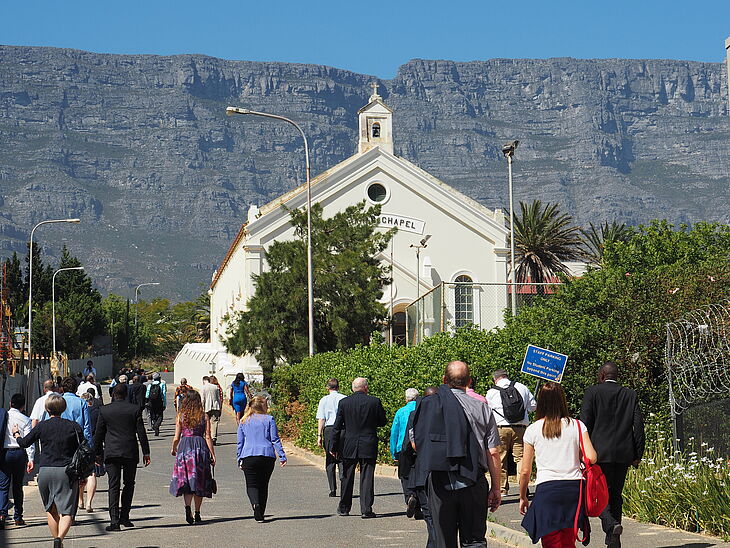
The time of apartheid
At the beginning of the 20th century, a policy of racial segregation, known as apartheid , began in South Africa - to the advantage of the whites - which was increasingly intensified after 1948 and which trampled on the human dignity of the non-white population. As a church to which almost exclusively black and coloured people belong, the Moravian Church in South Africa suffered severely under apartheid. Among other things, forced relocations led to the dissolution of six congregations and the relocation of the theological seminary from Gqeberha (Port Elizabeth) to Cape Town. Many members of the Moravian Church actively participated in the resistance, some went underground, some were imprisoned and some emigrated abroad.
During apartheid, it was very important for the Moravian Church in South Africa to receive solidarity and practical help from Germany and the worldwide Moravian Church. This included the service of individual brothers and sisters from Germany. The prevailing injustice was repeatedly denounced publicly through church partnerships.
In 1994, the apartheid laws were abolished and the era of racial segregation came to an end. However, the human injuries and economic and social consequences of apartheid are far from over. The continuing poverty of large sections of the population also causes poverty in the Moravian Church, especially in the Eastern Cape.
In 1993, the two provinces - with an office in Cape Town and one in Matatiele - were merged and divided into 12 districts. For many years, Genadendal was the seat of the church leadership until it was moved to Cape Town. Today it is located in the Lansdowne district. The church leadership consists of 16 people, one person from each of the twelve districts, a finance director and a three-member executive committee. It usually meets once a quarter. The Synod meets every four years. The Moravian Church in South Africa MCSA has a special partnership with the European-Continental Province, with the Evangelical Mission in Solidarity EMS being primarily responsible for maintaining this partnership.
Projektfotos/Project Photos
Ecumenical and networks
The MCSA is one of the Lutheran churches, which make up 4% of South Africa's Christian churches. It has a total of around 90 congregations with approximately 90,000 members, as well as 70 male and female pastors and some lay preachers. As many pastors will be retiring in the next few years, the MCSA is training its own full and part-time pastors at the Moravian Theological Centre in Heideveld, a district of Cape Town.
Within the MCSA there are strong, church-wide associations, e.g. for men's work, women's work, youth work, Sunday school work, choir work and brass work. The associations operate largely independently and organise many activities in addition to church events.
The MCSA is a member of the World Council of Churches WCC, the South African Council of Churches and the Lutheran Communion in Southern Africa LUCSA. The MCSA is a founding member of the Evangelical Mission in Solidarity EMS. Through its relationship with the EMS, the MCSA is involved in the ecumenical volunteer programme ÖFP North-South Exchange and South-North Exchange. Employees from EMS member churches serve for extended periods in South Africa and vice versa.
Social institutions, schools, economic initiatives
The MCSA focuses its work on the social sector. A large part of the community work is done by volunteers. The church supports the poor and marginalised through diaconal work, education and various projects. It maintains several social institutions such as the Elim Home.
Elim Home
Since 1963, Elim Home in South Africa has been taking care of more than 80 people with severe mental and physical disabilities, aged between 4 and 40. The residents are cared for and supported competently and lovingly under the maxim ‘Every life is valuable’. The help and support of the Elim Home is a great relief for the families concerned, as many come from poor backgrounds and have little access to medical care.
The residents receive personalised physiotherapy and occupational therapy and learn, within their abilities, how to do things independently. In addition, the home is developing new ideas and sustainable concepts: for example, residents can help with gardening in their own garden. The freshly harvested vegetables either end up on the plate or are sold to generate a small additional income. Solar panels have been installed on the roofs of the buildings, which not only saves on energy costs but also provides a sustainable source of energy in the region, where power cuts are frequent.
In the town of Elim, a mission settlement dating from 1825, Elim Home is the largest employer, providing work for around 45 women from the surrounding area.
Since 2013, two additional outreach groups have been established, each 40 kilometres from Elim Home. This ensures that people with disabilities whose families live too far away from Elim receive the care and therapy they need. It also allows family members to be better integrated into the project, thus strengthening community awareness.
When it was founded, Elim Home was the first and only institution for black children with disabilities in the Western Cape region. Today, it is still part of the MCSA's social welfare programme. Since the South African Ministry of Health covers only 40 percent of the home's costs, Elim Home needs our and your support.
For more than 60 years, the Elim Home in South Africa has been a home for 50 children and adults with multiple mental and physical disabilities. Here they are lovingly cared for and supported according to their abilities. Thanks to the financial support of some EMS member churches, a solar energy system was installed on the roof of Elim Home, making the home independent of the unstable power supply, which is subject to power cuts of up to 10 hours a day. Furthermore, the solar energy system reduces the rising costs of electricity.
Masangane Project
Many South Africans suffering from AIDS are unemployed and have been abandoned by their families. Their outlook for the future is bleak - they are denied the ability to lead a normal life. Although they receive vital antiretroviral medication free of charge from the state, medication alone does not solve their problems. This is why the Masangane Project (Xhosa for let us embrace each other) - the MCSA's AIDS programme - has been in existence since 1996. HIV-infected people receive holistic help in the form of counselling and pastoral care. In addition, Masangane also supports these people in dealing with the authorities, as this makes it easier for them to get access to essential medication.
Projektbilder/Project pictures
The aim of the Masangane Project is to give children and adults a regular life again. The project helps HIV-infected men and women to earn an income by providing them with chickens and building materials for stables. They earn their own money by rearing and selling the chickens. It is a big step for those affected to stand on their own two feet again, which gives them courage and strengthens their self-confidence.
Unfortunately, AIDS leaves many children orphaned - it is estimated that there are over one million in South Africa. The Masangane Project also provides them with food and education and helps them with their problems. Girls and boys receive help to apply for an orphan's pension, while kindergarten children are looked after all day in church kindergartens and receive hot meals there. For schoolchildren, the project pays for school uniforms and school fees. Time and again, the employees also discover so-called child households where both parents have died or cannot be found due to AIDS. In such cases, the children receive additional support in the form of food, clothing or household items. The carers, who in many cases are HIV-positive themselves, are also available to the children as a substitute mother.
In order to reach as many people as possible, Masangane Project has numerous volunteers who have been trained as home-based care workers in addition to the locations in the Eastern Cape region. They visit AIDS patients at home, document the progression of the disease and quickly recognise when a doctor is needed. As most of the staff are also HIV-positive, they give the patients hope that a normal life is possible despite the disease.
